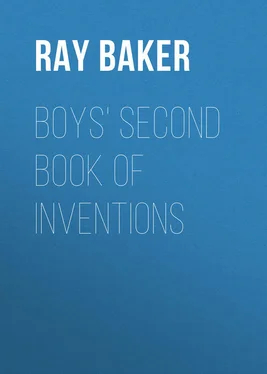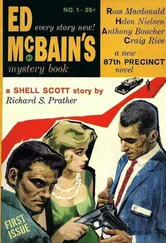Ray Baker - Boys' Second Book of Inventions
Здесь есть возможность читать онлайн «Ray Baker - Boys' Second Book of Inventions» — ознакомительный отрывок электронной книги совершенно бесплатно, а после прочтения отрывка купить полную версию. В некоторых случаях можно слушать аудио, скачать через торрент в формате fb2 и присутствует краткое содержание. Издательство: Иностранный паблик, Жанр: foreign_antique, foreign_prose, foreign_children, на английском языке. Описание произведения, (предисловие) а так же отзывы посетителей доступны на портале библиотеки ЛибКат.
- Название:Boys' Second Book of Inventions
- Автор:
- Издательство:Иностранный паблик
- Жанр:
- Год:неизвестен
- ISBN:нет данных
- Рейтинг книги:4 / 5. Голосов: 1
-
Избранное:Добавить в избранное
- Отзывы:
-
Ваша оценка:
- 80
- 1
- 2
- 3
- 4
- 5
Boys' Second Book of Inventions: краткое содержание, описание и аннотация
Предлагаем к чтению аннотацию, описание, краткое содержание или предисловие (зависит от того, что написал сам автор книги «Boys' Second Book of Inventions»). Если вы не нашли необходимую информацию о книге — напишите в комментариях, мы постараемся отыскать её.
Boys' Second Book of Inventions — читать онлайн ознакомительный отрывок
Ниже представлен текст книги, разбитый по страницам. Система сохранения места последней прочитанной страницы, позволяет с удобством читать онлайн бесплатно книгу «Boys' Second Book of Inventions», без необходимости каждый раз заново искать на чём Вы остановились. Поставьте закладку, и сможете в любой момент перейти на страницу, на которой закончили чтение.
Интервал:
Закладка:
Upon going to Paris Santos-Dumont at once took up the work of making himself familiar with ballooning in all of its practical aspects. He saw that if he were ever to build an air-ship he must first know all there was to know about balloon-making, methods of filling with gas, lifting capacities, the action of balloons in the air, and all the thousand and one things connected with ordinary ballooning. And Paris has always been the centre of this information. He regards this preliminary knowledge as indispensable to every air-ship builder. He says:
"Before launching out into the construction of air-ships I took pains to make myself familiar with the handling of spherical balloons. I did not hasten, but took plenty of time. In all, I made something like thirty ascensions; at first as a passenger, then as my own captain, and at last alone. Some of these spherical balloons I rented, others I had constructed for me. Of such I have owned at least six or eight. And I do not believe that without such previous study and experience a man is capable of succeeding with an elongated balloon, whose handling is so much more delicate. Before attempting to direct an air-ship, it is necessary to have learned in an ordinary balloon the conditions of the atmospheric medium; to have become acquainted with the caprices of the wind, now caressing and now brutal, and to have gone thoroughly into the difficulties of the ballast problem, from the triple point of view of starting, of equilibrium in the air, and of landing at the end of the trip. To go up in an ordinary balloon, at least a dozen times, seems to me an indispensable preliminary for acquiring an exact notion of the requisites for the construction and handling of an elongated balloon, furnished with its motor and propeller."
His first ascent in a balloon was made in 1897, when he was 24 years old, as a passenger with M. Machuron, who had then just returned from the Arctic regions, where he had helped to start Andrée on his ill-fated voyage in search of the North Pole. He found the sensations delightful, being so pleased with the experience that he subsequently secured a small balloon of his own, in which he made several ascents. He also climbed the Alps in order to learn more of the condition of the air at high altitudes.
In 1898 he set about experimentation in the building of a real air-ship or steerable balloon. Efforts had been made in this direction by former inventors, but with small success. As far back as 1852 Henri Gifford made the first of the familiar cigar-shaped balloons, trying steam as a motive power, but he soon found that an engine strong enough to propel the balloon was too heavy for the balloon to lift. That simple failure discouraged experimenters for a long time. In 1877 Dupuy de Lome tried steering a balloon by man power, but the man was not strong enough. In 1883 another Frenchman, Tissandier, experimented with electricity, but, as his batteries had to be light enough to be taken up in the balloon, they proved effective only in helping to weigh it down to earth again. Krebs and Renard, military aëronauts, succeeded better with electricity, for they could make a small circuit with their air-ship, provided only that no air was stirring. Enthusiasts cried out that the problem was solved, but the two aëronauts themselves, as good mathematicians, figured out that they would have to have a motor eight times more powerful than their own, and that without any increase in weight, which was an impossibility at that time.
Santos-Dumont saw plainly that none of these methods would work. What then was he to try? Why, simple enough: the petroleum motor from his automobile. The recent development of the motor-vehicle had produced a light, strong, durable motor. It was Santos-Dumont's first great claim to originality that he should have applied this to the balloon. He discovered no new principles, invented nothing that could be patented. The cigar-shaped balloon had long been used, so had the petroleum motor, but he put them together. And he did very much more than that. The very essence of success in aërial navigation is to secure light weight with great strength and power . The inventor who can build the lightest machine, which is also strong, will, other things being equal, have the greatest success. It is to Santos-Dumont's great credit that he was able to build a very light motor, that also gave a good horse-power, and a light balloon that was also very strong. The one great source of danger in using the petroleum motor in connection with a balloon is that the sparking of the motor will set fire to the inflammable hydrogen gas with which the balloon is filled, causing a terrible explosion. This, indeed, is what is thought to have caused the mortal mishap to Severo and his balloon. But Santos-Dumont was able to surmount this and many other difficulties of construction.
The inventor finally succeeded in making a motor – remarkable at that time – which, weighing only 66 pounds, would produce 3½ horse-power. It is easy to understand why a petroleum motor is such a power-producer for its size. The greater part of its fuel is in the air itself, and the air is all around the balloon, ready for use. The aëronaut does not have to take it up with him. That proportion of his fuel that he must carry, the petroleum, is comparatively insignificant in weight. A few figures will prove interesting. Two and one-half gallons of gasoline, weighing 15 pounds, will drive a 2½ horse-power autocycle 94 miles in four hours. Santos-Dumont's balloon needs less than 5⅓ gallons for a three hours' trip. This weighs but 37 pounds, and occupies a small cigar-shaped brass reservoir near the motor of his machine. An electric battery of the same horse-power would weigh 2,695 pounds.
Santos-Dumont tested his new motor very thoroughly by attaching it to a tricycle with which he made some record runs in and around Paris. Having satisfied himself that it was thoroughly serviceable he set about making the balloon, cigar-shaped, 82 feet long.
"To keep within the limit of weight," he says, "I first gave up the network and the outer cover of the ordinary balloon. I considered this sort of second envelope, holding the first within it, to be superfluous, and even harmful, if not dangerous. To the envelope proper I attached the suspension-cords of my basket directly, by means of small wooden rods introduced into horizontal hems, sewed on both sides along the stuff of the balloon for a great part of its length. Again, in order not to pass the 66 pounds weight, including varnish, I was obliged to choose Japan silk that was extremely fine, but fairly resisting. Up to this time no one had ever thought of using this for balloons intended to carry up an aëronaut, but only for little balloons carrying light registering apparatus for investigations in the upper air.
"I gave the order for this balloon to M. Lachambre. At first he refused to take it, saying that such a thing had never been made, and that he would not be responsible for my rashness. I answered that I would not change a thing in the plan of the balloon, if I had to sew it with my own hands. At last he agreed to sew and varnish the balloon as I desired."
After repeated trials of his motor in the basket – which he suspended in his workshop – and the making of a rudder of silk he was able, in September, 1898, to attempt real flying. But, after rising successfully in the air, the weight of the machinery and his own body swung beneath the fragile balloon was so great that while descending from a considerable height the balloon suddenly sagged down in the middle and began to shut up like a portfolio.
"At that moment," he said, "I thought that all was over, the more so as the descent, which had already become rapid, could no longer be checked by any of the usual means on board, where nothing worked.
"The descent became a rapid fall. Luckily, I was falling in the neighborhood of the soft, grassy pélouse of the Longchamps race-course, where some big boys were flying kites. A sudden idea struck me. I cried to them to grasp the end of my 100-meter guide-rope, which had already touched the ground, and to run as fast as they could with it against the wind ! They were bright young fellows, and they grasped the idea and the guide-rope at the same lucky instant. The effect of this help in extremis was immediate, and such as I had expected. By this manœuvre we lessened the velocity of the fall, and so avoided what would otherwise have been a terribly rough shaking up, to say the least. I was saved for the first time. Thanking the brave boys, who continued to aid me to pack everything into the air-ship's basket, I finally secured a cab and took the relic back to Paris."
Читать дальшеИнтервал:
Закладка:
Похожие книги на «Boys' Second Book of Inventions»
Представляем Вашему вниманию похожие книги на «Boys' Second Book of Inventions» списком для выбора. Мы отобрали схожую по названию и смыслу литературу в надежде предоставить читателям больше вариантов отыскать новые, интересные, ещё непрочитанные произведения.
Обсуждение, отзывы о книге «Boys' Second Book of Inventions» и просто собственные мнения читателей. Оставьте ваши комментарии, напишите, что Вы думаете о произведении, его смысле или главных героях. Укажите что конкретно понравилось, а что нет, и почему Вы так считаете.












